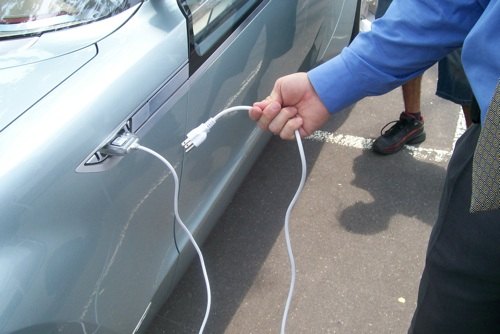Volt Birth Watch 159: MSM Double Negative on Volt's Chances of Success
The numbers for the Chevrolet plug-in hybrid electric Volt—running costs vs. the competition and the manufacturer’s margin—don’t add up. Never did. Right from its inception, GM was demurring on the timeline for the theoretical vehicle’s theoretical profitability. Early adopters, economy of scale, yada yada yada. Even after GM’s prearranged a $7500 tax credit with Uncle Sugar—an outrageous tilting of the playing field in the former bankrupt’s favor—the Volt remains a guaranteed, sure-fire money loser. Even if the price of gas soars, the Volt will not be an economic proposition. These facts have been largely lost on the mainstream media (MSM), whose myopia for all things green and beautiful has blinded them to the equations that will seal its fate. And even when they do crunch the numbers, they refuse to see the light. To wit CNNMoney. Make the jump to do the math. Otherwise, GM’s headlong rush down the obfuscation highway has a new champion: “So it’s not impossible that the Volt could become a sales success, even if the strict dollar analysis does not work out for it.”
Driving a typical 14,000 miles a year, or 38 miles a day, the Prius would use about 280 gallons of gasoline.
With gas at its current price of about $2.65 a gallon, that would come to about $742 a year in gas, or $421 more than the Volt owners would pay if they can stick with electricity.
Even if gas goes back to the record high of $4.11and stays there, gassing up a Prius would cost about $1,150 a year, giving the Volt an $830 a year cost savings.
But a Prius costs $25,428, on average, according to sales data from Edmunds.com, while GM will probably have to spend $40,000 or more to build each Volt.
While Volt buyers will get a $7,500 tax credit that reduces the still undisclosed purchase price by that amount, the fact is that GM will have to subsidize much of the remaining $7,000 difference in cost to make it competitive with the Prius.
At current gas prices, the $421 a year savings over a period of six years that a new car is typically owned, would mean that a Volt would only be cost competitive with a Prius if was about $34,500 before the tax credit.
That means GM would have to take about a $5,500 loss on each Volt if it is to be strictly competitive.
If you assume modest sales of 20,000 Volts the first year, that would mean about $110 million in additional losses for the cash-strapped automaker.
More by Robert Farago
Latest Car Reviews
Read moreLatest Product Reviews
Read moreRecent Comments
- Dave M. IMO this was the last of the solidly built MBs. Yes, they had the environmentally friendly disintegrating wiring harness, but besides that the mechanicals are pretty solid. I just bought my "forever" car (last new daily driver that'll ease me into retirement), but a 2015-16 E Class sedan is on my bucket list for future purchase. Beautiful design....
- Rochester After years of self-driving being in the news, I still don't understand the psychology behind it. Not only don't I want this, but I find the idea absurd.
- Douglas This timeframe of Mercedes has the self-disintegrating engine wiring harness. Not just the W124, but all of them from the early 90's. Only way to properly fix it is to replace it, which I understand to be difficult to find a new one/do it/pay for. Maybe others have actual experience with doing so and can give better hope. On top of that, it's a NH car with "a little bit of rust", which means to about anyone else in the USA it is probably the rustiest W124 they have ever seen. This is probably a $3000 car on a good day.
- Formula m How many Hyundai and Kia’s do not have the original engine block it left the factory with 10yrs prior?
- 1995 SC I will say that year 29 has been a little spendy on my car (Motor Mounts, Injectors and a Supercharger Service since it had to come off for the injectors, ABS Pump and the tool to cycle the valves to bleed the system, Front Calipers, rear pinion seal, transmission service with a new pan that has a drain, a gaggle of capacitors to fix the ride control module and a replacement amplifier for the stereo. Still needs an exhaust manifold gasket. The front end got serviced in year 28. On the plus side blank cassettes are increasingly easy to find so I have a solid collection of 90 minute playlists.


































Comments
Join the conversation
ChristyGarwood: I think this is where people will get hosed. Let's say that it costs $2 a night to charge my Volt. That's $60 a month.. $720 a year added to the cost of the car. Maybe that's less than the gas, but it sure needs to figure into the Total Cost of Ownership. American's (myself included) rarely consider the cost of electricity when we bring home something with a plug on it.
Let’s say that it costs $2 a night to charge my Volt. That’s $60 a month.. $720 a year added to the cost of the car. Uh no, for areas that are $0.12 Kwh (which is the US Average) the Volt costs 40 cents to charge 40 miles. Not even remotely $2 a night. Electricity is REALLY cheap at night, almost 1/3 the price of day time power.